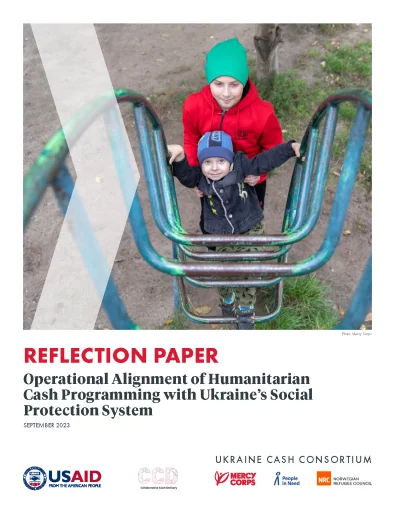Operational Alignment of Humanitarian Cash Programming with Ukraine’s Social Protection System
This paper explores the extent to which humanitarian Multipurpose Cash Assistance (MPCA) in Ukraine has been able to leverage different elements of the delivery chain of national social protection (SP) programming. The basis of this paper is the framework developed by Seyfert et al., in their 2019 paper Unbundled: A Framework for Connecting Safety Nets and Humanitarian Assistance in Refugee Setting. Under this framework, humanitarian MPCA happens along a continuum from no integration, to full integration with national SP systems. This continuum happens for each individual element of the delivery chain rather than one single approach applied across all elements.
Significant progress has been made on the Grand Bargain Commitment to shift humanitarian assistance to cash transfer programming, with many operational actors adopting a “cash first” approach (Metcalfe-Hough, et al., 2021) and accumulating and sharing lessons learned throughout different humanitarian responses. Leveraging national SP systems to deliver humanitarian cash assistance has not advanced as quickly as the adoption of cash assistance modalities, despite the stated importance of SP systems to achieving the humanitarian-development nexus. As the Ukraine crisis is well into its second year, with no clear sign of abatement, greater coordination is required between humanitarian and development actors, as well as the international community and the government to reduce humanitarian needs, risks and vulnerabilities, as called for in The United Nation’s Office for the Coordination of Humanitarian Affairs’ (OCHA) New Ways of Working (2017) paper. Such an approach is guided by the “reinforce, do not replace, national and local systems” principle of the Agenda for Humanity Transformation Commitment (Loquercio et al., 2017). This approach is directly related to the localization outcome of the World Humanitarian Summit, which reaffirmed the role of national and local actors in the delivery of assistance (OCHA, 2017).
There are significant similarities between humanitarian cash assistance and SP, but there are also key differences that may impede leveraging the SP system to deliver assistance. Understanding these differences is as important as understanding the context in which linkages could occur. There is, at times, tension between humanitarian principles and leveraging national systems to deliver assistance, especially where the government is party to the conflict.
Leveraging national systems to deliver humanitarian assistance can potentially compromise some humanitarian principles, notably, in the case of Ukraine, neutrality and independence. For instance, neutrality, or not being viewed as supporting one side over another, is critical for humanitarians to safely access areas where active hostilities occur. If humanitarian actors are perceived to be collaborating and aligned with the government, access to non-government-controlled areas may be blocked or humanitarian actors may become targets themselves. This is a concern not only for actors operating in Ukraine but also for their operations in other countries in which the Russian Federation is also present. Issues around independence are also a key concern, particularly around data protection standards. Currently, data is shared by the government via eDopomoga through data-sharing agreements with humanitarian actors, with the obligation for humanitarian actors to share beneficiary data with the government. However, individuals may register for humanitarian assistance directly with humanitarian agencies rather than through the government platform due to fears of conscription, and sharing data with the government could raise the risk that it is used for general mobilization efforts rather than SP purposes (coordination, targeting, etc.).
Much attention has been devoted to looking at the role of SP in the “humanitarian-development nexus” in lower-income or fragile contexts with nascent or limited SP systems. This paper focuses on a middle-income context with a robust SP system that provides contributory and non-contributory cash, concessions, and in-kind programs to address various lifecycle contingencies and poverty. Interestingly, despite the maturity of the SP system in Ukraine, very little of the MPCA response is nationally led or piggybacks on existing systems, with the majority of delivery chain elements designed as standalone components or somewhat aligned with the national system. This may be because of the nature of the emergency. In conflict situations, particularly where the government is party to the conflict, there may be implications for humanitarian principles, notably neutrality, and independence, which can make leveraging the government system less prudent.
This paper analyzes the operational alignment of the response to reflect on the levels of and existing barriers to alignment along the delivery cycle of MPCA and should be read in conjunction with the Collaborative Cash Delivery (CCD) Network/Ukraine Cash Consortium (UCC)’s paper, which presents program design options for humanitarian cash programming aligning to the SP system in Ukraine. That paper includes a more in-depth analysis of the SP system in Ukraine, as well as the humanitarian response.



